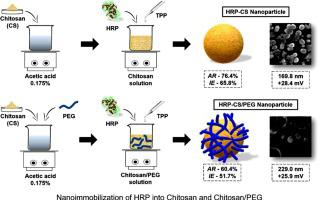当前位置:
X-MOL 学术
›
Process Biochem.
›
论文详情
Our official English website, www.x-mol.net, welcomes your
feedback! (Note: you will need to create a separate account there.)
Immobilization and characterization of Horseradish Peroxidase into Chitosan and Chitosan/PEG nanoparticles: A comparative study
Process Biochemistry ( IF 3.7 ) Pub Date : 2020-11-01 , DOI: 10.1016/j.procbio.2020.08.007 Micael Nunes Melo , Fernanda Menezes Pereira , Matheus Alves Rocha , Jesica Gonçalves Ribeiro , Fernando Mendonça Diz , Wesley Formentin Monteiro , Rosane Angélica Ligabue , Patrícia Severino , Alini Tinoco Fricks
Process Biochemistry ( IF 3.7 ) Pub Date : 2020-11-01 , DOI: 10.1016/j.procbio.2020.08.007 Micael Nunes Melo , Fernanda Menezes Pereira , Matheus Alves Rocha , Jesica Gonçalves Ribeiro , Fernando Mendonça Diz , Wesley Formentin Monteiro , Rosane Angélica Ligabue , Patrícia Severino , Alini Tinoco Fricks

|
Abstract Chitosan (CS) is considered a suitable biomaterial for enzyme immobilization. CS combination with polyethylene glycol (PEG) can improve the biocompatibility and the properties of the immobilized system. Thus, the present work investigated the effect of the PEG in the horseradish peroxidase (HRP) immobilization into chitosan nanoparticles from the morphological, physicochemical, and biochemical perspectives. CS and CS/PEG nanoparticles were obtained by ionotropic gelation and provided immobilization efficiencies (IE) of 65.8 % and 51.7 % and activity recovery (AR) of 76.4 % and 60.4 %, respectively. The particles were characterized by DLS, ZP, SEM, FTIR, TGA and DSC analysis. Chitosan nanoparticles showed size around 135 nm and increased to 229 nm after PEG addition and HRP immobilization. All particles showed positive surface charges (20−28 mV). Characterizations suggest nanoparticles formation and effective immobilization process. Similar values for optimum temperature and pH for immobilized HRP into both nanoparticles were found (45 °C, 7.0). Vmax value decreased by 5.07 to 3.82 and 4.11 mM/min and KM increased by 17.78 to 18.28 and 19.92 mM for free and immobilized HRP into chitosan and chitosan/PEG nanoparticles, respectively. Another biochemical parameters (Kcat, Ke, and Kα) evaluated showed a slight reduction for the immobilized enzyme in both nanoparticles compared to the free enzyme.
中文翻译:

辣根过氧化物酶在壳聚糖和壳聚糖/PEG 纳米颗粒中的固定化和表征:比较研究
摘要 壳聚糖(CS)被认为是一种适合酶固定化的生物材料。CS与聚乙二醇(PEG)的结合可以提高固定化系统的生物相容性和性能。因此,本工作从形态学、物理化学和生化角度研究了 PEG 在辣根过氧化物酶 (HRP) 固定化到壳聚糖纳米颗粒中的作用。CS 和 CS/PEG 纳米粒子是通过离子键凝胶化获得的,它们的固定效率 (IE) 分别为 65.8% 和 51.7%,活性恢复率 (AR) 分别为 76.4% 和 60.4%。通过DLS、ZP、SEM、FTIR、TGA和DSC分析对颗粒进行表征。壳聚糖纳米颗粒显示出大约 135 nm 的大小,并在添加 PEG 和 HRP 固定后增加到 229 nm。所有颗粒都显示出正表面电荷 (20-28 mV)。表征表明纳米颗粒的形成和有效的固定过程。发现固定在两种纳米颗粒中的 HRP 的最佳温度和 pH 值相似(45°C,7.0)。Vmax 值分别降低了 5.07 至 3.82 和 4.11 mM/min,KM 分别增加了 17.78 至 18.28 和 19.92 mM,分别用于游离和固定化到壳聚糖和壳聚糖/PEG 纳米颗粒中的 HRP。评估的另一个生化参数(Kcat、Ke 和 Kα)显示,与游离酶相比,两种纳米颗粒中的固定化酶略有减少。对于游离和固定在壳聚糖和壳聚糖/PEG 纳米颗粒中的 HRP,82 和 4.11 mM/min 和 KM 分别增加了 17.78 到 18.28 和 19.92 mM。评估的另一个生化参数(Kcat、Ke 和 Kα)显示,与游离酶相比,两种纳米颗粒中的固定化酶略有减少。对于游离和固定在壳聚糖和壳聚糖/PEG 纳米颗粒中的 HRP,82 和 4.11 mM/min 和 KM 分别增加了 17.78 到 18.28 和 19.92 mM。评估的另一个生化参数(Kcat、Ke 和 Kα)显示,与游离酶相比,两种纳米颗粒中的固定化酶略有减少。
更新日期:2020-11-01
中文翻译:

辣根过氧化物酶在壳聚糖和壳聚糖/PEG 纳米颗粒中的固定化和表征:比较研究
摘要 壳聚糖(CS)被认为是一种适合酶固定化的生物材料。CS与聚乙二醇(PEG)的结合可以提高固定化系统的生物相容性和性能。因此,本工作从形态学、物理化学和生化角度研究了 PEG 在辣根过氧化物酶 (HRP) 固定化到壳聚糖纳米颗粒中的作用。CS 和 CS/PEG 纳米粒子是通过离子键凝胶化获得的,它们的固定效率 (IE) 分别为 65.8% 和 51.7%,活性恢复率 (AR) 分别为 76.4% 和 60.4%。通过DLS、ZP、SEM、FTIR、TGA和DSC分析对颗粒进行表征。壳聚糖纳米颗粒显示出大约 135 nm 的大小,并在添加 PEG 和 HRP 固定后增加到 229 nm。所有颗粒都显示出正表面电荷 (20-28 mV)。表征表明纳米颗粒的形成和有效的固定过程。发现固定在两种纳米颗粒中的 HRP 的最佳温度和 pH 值相似(45°C,7.0)。Vmax 值分别降低了 5.07 至 3.82 和 4.11 mM/min,KM 分别增加了 17.78 至 18.28 和 19.92 mM,分别用于游离和固定化到壳聚糖和壳聚糖/PEG 纳米颗粒中的 HRP。评估的另一个生化参数(Kcat、Ke 和 Kα)显示,与游离酶相比,两种纳米颗粒中的固定化酶略有减少。对于游离和固定在壳聚糖和壳聚糖/PEG 纳米颗粒中的 HRP,82 和 4.11 mM/min 和 KM 分别增加了 17.78 到 18.28 和 19.92 mM。评估的另一个生化参数(Kcat、Ke 和 Kα)显示,与游离酶相比,两种纳米颗粒中的固定化酶略有减少。对于游离和固定在壳聚糖和壳聚糖/PEG 纳米颗粒中的 HRP,82 和 4.11 mM/min 和 KM 分别增加了 17.78 到 18.28 和 19.92 mM。评估的另一个生化参数(Kcat、Ke 和 Kα)显示,与游离酶相比,两种纳米颗粒中的固定化酶略有减少。











































 京公网安备 11010802027423号
京公网安备 11010802027423号